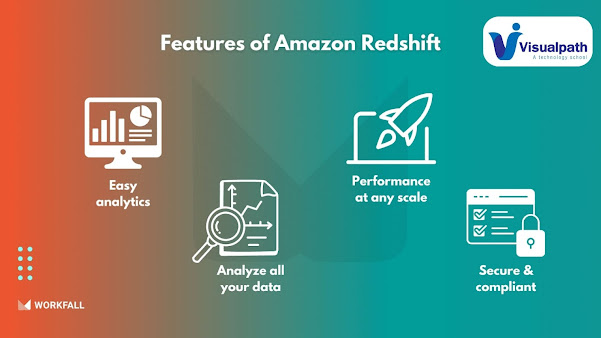Performance Features of Amazon Redshift
Amazon Redshift is a fully managed, petabyte-scale data warehouse service in the cloud that offers high-performance analysis using a distributed architecture. It provides several features and optimizations for improving performance. - Amazon Redshift Online Training
1. Columnar Storage: Amazon
Redshift uses a columnar storage format, storing data in columns rather than
rows. This allows for better compression and faster query performance since
only the necessary columns are read during a query.
2. Massively Parallel Processing
(MPP): Redshift employs a MPP architecture, distributing data and query
processing across multiple nodes in a cluster. This parallelism enhances
performance by allowing queries to be executed in parallel across nodes. - Amazon
Redshift Training in Hyderabad
3. Automatic Compression:
Redshift automatically compresses data to minimize storage requirements and
improve query performance. Compression reduces the amount of data that needs to
be read from disk during queries.
4. Distribution Keys: Users can
define distribution keys for tables, determining how data is distributed across
nodes. Well-chosen distribution keys can significantly improve query
performance by minimizing data movement during query execution.
5. Sort Keys: Sort keys determine
the physical order of data in tables, helping to reduce the amount of data that
needs to be scanned during queries. Appropriate use of sort keys can optimize
query performance.
6. Query Optimization: Redshift
includes a query optimizer that evaluates and selects the most efficient
execution plan for a given query. It considers factors like table statistics,
distribution and sort keys, and other metadata to generate optimized execution
plans. - Amazon
RedShift Training
7. Materialized Views: Amazon
Redshift supports materialized views, which are precomputed query results that
can significantly improve query performance for specific types of analytical
queries.
8. Concurrency Scaling: For
improved performance in concurrent query scenarios, Redshift offers Concurrency
Scaling. It allows the automatic addition of extra computing resources to
handle spikes in query loads, providing consistent performance even during peak
usage.
9. WLM (Workload Management):
Redshift enables users to define and manage query queues and allocate resources
based on workload priorities. This ensures that critical queries get the
necessary resources for optimal performance. - Amazon
Redshift Courses Online
10. Advanced Analytics: Redshift
integrates with various analytics and machine learning tools, allowing users to
perform complex analytics and gain insights directly within the data warehouse.
11. Redshift Spectrum: This
feature allows users to query data stored in Amazon S3 directly from Redshift,
extending the data warehouse's capabilities to analyze both on-premises and
cloud data.
By leveraging these features,
users can optimize and enhance the performance of their data warehouse
workloads in Amazon Redshift. It's essential to carefully design tables, choose
appropriate keys, and use best practices to get the most out of Redshift's
performance capabilities.
Visualpath is the Leading and Best Institute for learning Redshift Training in Hyderabad. We provide Amazon Redshift Online
Training, you will get the best course at an affordable cost.
Attend Free Demo Call on - +91-9989971070.
Visit Our Blog: https://amazonredshiftonlinetraining.blogspot.com/
Visit: https://www.visualpath.in/amazon-redshift-online-training.html




Comments
Post a Comment